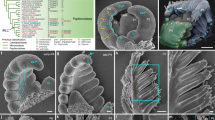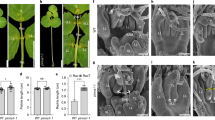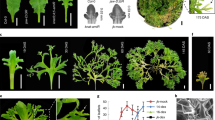Abstract
Diverse leaf forms in nature can be categorized as simple or compound. Simple leaves, such as those of petunia, have a single unit of blade, whereas compound leaves, such as those of tomato, have several units of blades called leaflets. Compound leaves can be pinnate, with leaflets arranged in succession on a rachis, or palmate, with leaflets clustered together at the leaf tip. The mechanisms that generate these various leaf forms are largely unknown. The upper (adaxial) surface is usually different from the bottom (abaxial) surface in both simple and compound leaves. In species with simple leaves, the specification of adaxial and abaxial cells is important for formation of the leaf blade1,2, and the MYB transcription factor gene PHANTASTICA (PHAN) is involved in maintaining the leaf adaxial (upper) domain3,4. Here we show that downregulation of PHAN is sufficient to reduce the adaxial domain of leaf primordia and to change pinnate compound leaves into palmate compound leaves. Furthermore, this mechanism seems to be shared among compound leaves that arose independently.
This is a preview of subscription content, access via your institution
Access options
Subscribe to this journal
Receive 51 print issues and online access
$199.00 per year
only $3.90 per issue
Buy this article
- Purchase on Springer Link
- Instant access to full article PDF
Prices may be subject to local taxes which are calculated during checkout




Similar content being viewed by others
References
McConnell, J. R. et al. Role of PHABULOSA and PHAVOLUTA in determining radial patterning in shoots. Nature 411, 709–713 (2001)
Waites, R. & Hudson, A. phantastica: a gene required for dorsoventrality of leaves in Antirrhinum majus. Development 121, 2143–2154 (1995)
Sun, Y., Zhou, Q., Zhang, W., Fu, Y. & Huang, H. ASYMMETRIC LEAVES1, an Arabidopsis gene that is involved in the control of cell differentiation in leaves. Planta 214, 694–702 (2002)
Waites, R., Selvadurai, H. R. N., Oliver, I. R. & Hudson, A. The Phantastica gene encodes a MYB transcription factor involved in growth and dorsoventrality of lateral organs in Antirrhinum. Cell 93, 779–789 (1998)
Pien, S., Wyrzykowska, J. & Fleming, A. J. Novel marker genes for early leaf development indicate spatial regulation of carbohydrate metabolism within the apical meristem. Plant J. 25, 663–674 (2001)
Koltai, H. & Bird, D. M. Epistatic repression of PHANTASTICA and class 1 KNOTTED genes is uncoupled in tomato. Plant J. 22, 455–459 (2000)
Bharathan, G. et al. Homologies in leaf form inferred from KNOXI gene expression during development. Science 296, 1858–1860 (2002)
Gleissberg, S. & Kadereit, J. W. Evolution of leaf morphogenesis: evidence from developmental and phylogenetic data in Papaveraceae. Int. J. Plant Sci. 160, 787–794 (1999)
Averof, M. & Patel, N. H. Crustacean appendage evolution associated with changes in Hox gene expression. Nature 388, 682–686 (1997)
Carroll, S. B. Endless forms: the evolution of gene regulation and morphological diversity. Cell 101, 577–580 (2000)
Cubas, P., Vincent, C. & Coen, E. An epigenetic mutation responsible for natural variation in floral symmetry. Nature 401, 157–161 (1999)
Gellon, G. & McGinnis, W. Shaping animal body plans in development and evolution by modulation of Hox expression patterns. BioEssays 20, 116–125 (1998)
Byrne, M. E. et al. Asymmetric leaves1 mediates leaf patterning and stem cell function in Arabidopsis. Nature 408, 967–971 (2000)
Timmermans, M. C. P., Hudson, A., Becraft, P. W. & Nelson, T. Rough sheath2: a Myb protein that represses knox homeobox genes in maize lateral organ primordia. Science 284, 151–153 (1999)
Tsiantis, M., Schneeberger, R., Golz, J. F., Freeling, M. & Langdale, J. A. The maize roughsheath2 gene and leaf development programs in monocot and dicot plants. Science 284, 154–156 (1999)
McCormick, S. in Plant Tissue Culture Manual, Fundamentals and Applications, Vol. B6 (ed. Lindsey, K.) 1–9 (Kluwer, Dordrecht, 1991)
Ruiz-Medrano, R., Xoconostle-Cazares, B. & Lucas, W. J. Phloem long-distance transport of CmNACP mRNA: implications for supracellular regulation in plants. Development 126, 4405–4419 (1999)
Jackson, D., Veit, B. & Hake, S. Expression of maize KNOTTED 1 related homeobox genes in the shoot apical meristem predicts patterns of morphogenesis in the vegetative shoot. Development 120, 405–413 (1994)
Kessler, S., Kim, M., Pham, T., Weber, N. & Sinha, N. Mutations altering leaf morphology in tomato. Int. J. Plant Sci. 162, 475–492 (2001)
Acknowledgements
We thank J. Harada, T. Kellogg, B. Reinhart and members of the Sinha lab for comments on the manuscript; T. Metcalf and E. Sandoval for plant materials; and E. Dean and the UC Davis John Tucker herbarium. This work was supported by Jastro Shields and Elsie Stocking fellowships to M.K., and by awards from the NSF to N.R.S.
Author information
Authors and Affiliations
Corresponding author
Ethics declarations
Competing interests
The authors declare that they have no competing financial interests.
Rights and permissions
About this article
Cite this article
Kim, M., McCormick, S., Timmermans, M. et al. The expression domain of PHANTASTICA determines leaflet placement in compound leaves. Nature 424, 438–443 (2003). https://doi.org/10.1038/nature01820
Received:
Accepted:
Issue Date:
DOI: https://doi.org/10.1038/nature01820
This article is cited by
-
Hippophae rhamnoides N-glycoproteome analysis: a small step towards sea buckthorn proteome mining
Physiology and Molecular Biology of Plants (2016)
-
Oriented cell division shapes carnivorous pitcher leaves of Sarracenia purpurea
Nature Communications (2015)
-
What determines a leaf's shape?
EvoDevo (2014)
-
Conserved roles for Polycomb Repressive Complex 2 in the regulation of lateral organ development in Aquilegia x coerulea ‘Origami’
BMC Plant Biology (2013)
-
Usual and unusual development of the dicot leaf: involvement of transcription factors and hormones
Plant Cell Reports (2013)
Comments
By submitting a comment you agree to abide by our Terms and Community Guidelines. If you find something abusive or that does not comply with our terms or guidelines please flag it as inappropriate.



